Citibank 2012 Annual Report Download - page 7
Download and view the complete annual report
Please find page 7 of the 2012 Citibank annual report below. You can navigate through the pages in the report by either clicking on the pages listed below, or by using the keyword search tool below to find specific information within the annual report.-
 1
1 -
 2
2 -
 3
3 -
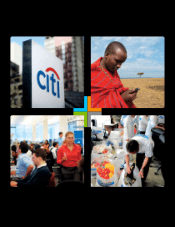 4
4 -
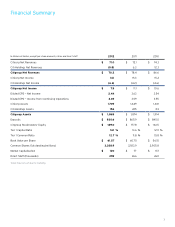 5
5 -
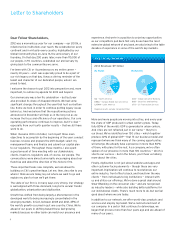 6
6 -
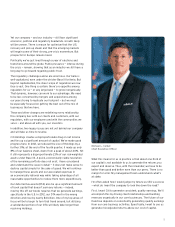 7
7 -
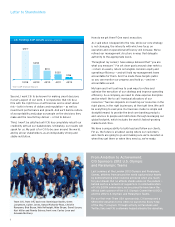 8
8 -
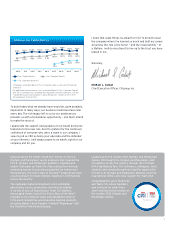 9
9 -
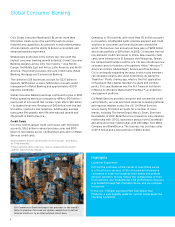 10
10 -
 11
11 -
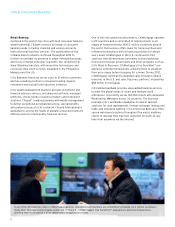 12
12 -
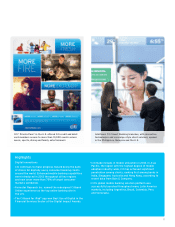 13
13 -
 14
14 -
 15
15 -
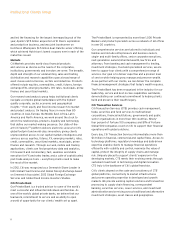 16
16 -
 17
17 -
 18
18 -
 19
19 -
 20
20 -
 21
21 -
 22
22 -
 23
23 -
 24
24 -
 25
25 -
 26
26 -
 27
27 -
 28
28 -
 29
29 -
 30
30 -
 31
31 -
 32
32 -
 33
33 -
 34
34 -
 35
35 -
 36
36 -
 37
37 -
 38
38 -
 39
39 -
 40
40 -
 41
41 -
 42
42 -
 43
43 -
 44
44 -
 45
45 -
 46
46 -
 47
47 -
 48
48 -
 49
49 -
 50
50 -
 51
51 -
 52
52 -
 53
53 -
 54
54 -
 55
55 -
 56
56 -
 57
57 -
 58
58 -
 59
59 -
 60
60 -
 61
61 -
 62
62 -
 63
63 -
 64
64 -
 65
65 -
 66
66 -
 67
67 -
 68
68 -
 69
69 -
 70
70 -
 71
71 -
 72
72 -
 73
73 -
 74
74 -
 75
75 -
 76
76 -
 77
77 -
 78
78 -
 79
79 -
 80
80 -
 81
81 -
 82
82 -
 83
83 -
 84
84 -
 85
85 -
 86
86 -
 87
87 -
 88
88 -
 89
89 -
 90
90 -
 91
91 -
 92
92 -
 93
93 -
 94
94 -
 95
95 -
 96
96 -
 97
97 -
 98
98 -
 99
99 -
 100
100 -
 101
101 -
 102
102 -
 103
103 -
 104
104 -
 105
105 -
 106
106 -
 107
107 -
 108
108 -
 109
109 -
 110
110 -
 111
111 -
 112
112 -
 113
113 -
 114
114 -
 115
115 -
 116
116 -
 117
117 -
 118
118 -
 119
119 -
 120
120 -
 121
121 -
 122
122 -
 123
123 -
 124
124 -
 125
125 -
 126
126 -
 127
127 -
 128
128 -
 129
129 -
 130
130 -
 131
131 -
 132
132 -
 133
133 -
 134
134 -
 135
135 -
 136
136 -
 137
137 -
 138
138 -
 139
139 -
 140
140 -
 141
141 -
 142
142 -
 143
143 -
 144
144 -
 145
145 -
 146
146 -
 147
147 -
 148
148 -
 149
149 -
 150
150 -
 151
151 -
 152
152 -
 153
153 -
 154
154 -
 155
155 -
 156
156 -
 157
157 -
 158
158 -
 159
159 -
 160
160 -
 161
161 -
 162
162 -
 163
163 -
 164
164 -
 165
165 -
 166
166 -
 167
167 -
 168
168 -
 169
169 -
 170
170 -
 171
171 -
 172
172 -
 173
173 -
 174
174 -
 175
175 -
 176
176 -
 177
177 -
 178
178 -
 179
179 -
 180
180 -
 181
181 -
 182
182 -
 183
183 -
 184
184 -
 185
185 -
 186
186 -
 187
187 -
 188
188 -
 189
189 -
 190
190 -
 191
191 -
 192
192 -
 193
193 -
 194
194 -
 195
195 -
 196
196 -
 197
197 -
 198
198 -
 199
199 -
 200
200 -
 201
201 -
 202
202 -
 203
203 -
 204
204 -
 205
205 -
 206
206 -
 207
207 -
 208
208 -
 209
209 -
 210
210 -
 211
211 -
 212
212 -
 213
213 -
 214
214 -
 215
215 -
 216
216 -
 217
217 -
 218
218 -
 219
219 -
 220
220 -
 221
221 -
 222
222 -
 223
223 -
 224
224 -
 225
225 -
 226
226 -
 227
227 -
 228
228 -
 229
229 -
 230
230 -
 231
231 -
 232
232 -
 233
233 -
 234
234 -
 235
235 -
 236
236 -
 237
237 -
 238
238 -
 239
239 -
 240
240 -
 241
241 -
 242
242 -
 243
243 -
 244
244 -
 245
245 -
 246
246 -
 247
247 -
 248
248 -
 249
249 -
 250
250 -
 251
251 -
 252
252 -
 253
253 -
 254
254 -
 255
255 -
 256
256 -
 257
257 -
 258
258 -
 259
259 -
 260
260 -
 261
261 -
 262
262 -
 263
263 -
 264
264 -
 265
265 -
 266
266 -
 267
267 -
 268
268 -
 269
269 -
 270
270 -
 271
271 -
 272
272 -
 273
273 -
 274
274 -
 275
275 -
 276
276 -
 277
277 -
 278
278 -
 279
279 -
 280
280 -
 281
281 -
 282
282 -
 283
283 -
 284
284 -
 285
285 -
 286
286 -
 287
287 -
 288
288 -
 289
289 -
 290
290 -
 291
291 -
 292
292 -
 293
293 -
 294
294 -
 295
295 -
 296
296 -
 297
297 -
 298
298 -
 299
299 -
 300
300 -
 301
301 -
 302
302 -
 303
303 -
 304
304 -
 305
305 -
 306
306 -
 307
307 -
 308
308 -
 309
309 -
 310
310 -
 311
311 -
 312
312 -
 313
313 -
 314
314 -
 315
315 -
 316
316 -
 317
317 -
 318
318 -
 319
319 -
 320
320 -
 321
321 -
 322
322 -
 323
323 -
 324
324
 |
 |

5
Yet our company — and our industry — still face significant
economic, political and regulatory headwinds. Growth likely
will be uneven. There is reason for optimism that the U.S.
recovery will pick up steam and that the emerging markets
will regain some of their strong, pre-crisis momentum. But
prospects for Europe remain mixed.
Politically, we’ve just lived through a year of elections and
transitions around the globe. Public pressures — intense during
the crisis — remain, showing that as an industry we still have a
long way to go toward regaining public trust.
The regulatory challenges alone are enormous. Our bank is
well-capitalized, even under the stricter Basel III criteria. But
beyond capitalization, the sheer scope of regulation we now
face is vast. One thing is certain: there’s no appetite among
regulators for us — or any large bank — to grow inorganically.
That dynamic, however, can work to our advantage. We need
to be less concerned by mergers and acquisitions among
our peers trying to replicate our footprint — but we must
be especially focused on getting the best out of the mix of
businesses that we have.
These and other changes are redefining every relationship
this company has: with our clients and customers, with our
regulators, with our employees and with the communities we
serve — and above all with you, our investors.
In addition, two legacy issues are not yet behind our company
and will take us time to resolve.
Citi Holdings creates a disproportionate drag on net income
and ties up a significant amount of capital. We’ve made good
progress here. In 2012, we reduced the size of Holdings by a
further 31%; at the end of the fourth quarter, it made up only
8% of our balance sheet, down from a peak of about 40%. Yet
it still represents a disproportionate 23% of our risk-weighted
assets under Basel III. A quick, economically viable resolution
of the remaining portfolio does not exist. I have considered
and understand the issue in detail — it does not make sense to
destroy capital simply for the sake of speed. We will continue
to manage these assets and our associated expenses in
an economically rational way while taking advantage of all
reasonable opportunities to reduce them more expeditiously.
Our deferred tax assets (DTA) also tie up a significant amount
of book capital that doesn’t earn any returns — indeed,
moving this off our books requires that we generate earnings,
specifically in the U.S. In 2012, our DTA went in the wrong
direction and rose by nearly $4 billion. One of my top areas of
focus will be to begin to turn that trend around, but utilizing
a substantial portion of our DTA will likely take longer than
resolving Holdings.
What this means for us in practice is that about one-third of
our capital is not available to us to generate the returns you
expect and deserve. Thus, with the remainder, we have to be
better than good and better even than our peers. There is no
margin for error. My management team understands what’s
at stake.
I’m often asked how I would judge my tenure as CEO a success
— what do I want the company to look like down the road?
First, I want Citi to generate consistent, quality earnings. We’ll
accomplish this by driving client relationships and building
revenues organically in our core businesses. The future of our
franchise depends on consistently generating quality earnings
from our core business activities. Specifically, I want to see us
generate risk-adjusted returns above our cost of capital.
Michael L. Corbat
Chief Executive Officer
